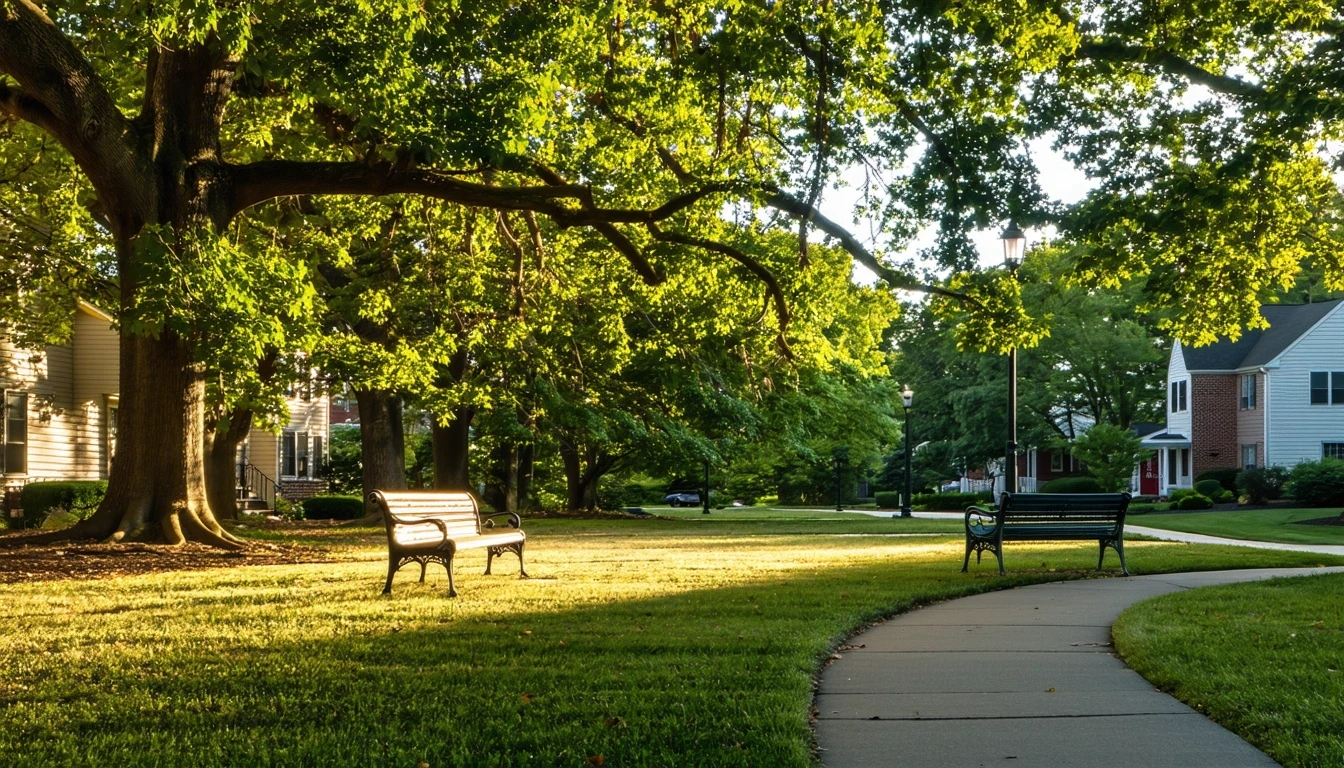
Silver Spring, MD vs. College Park, MD: Cost of Living Comparison (2025)
When relocating to the Washington D.C. metro area, many people find themselves comparing the cost of living between Silver Spring and College Park. Both Maryland suburbs offer a mix of urban amenities and residential neighborhoods, making them attractive options for families and young professionals alike. But with the cost of living in Silver Spring and College Park continuing to evolve, which city provides the best value in 2025? Let’s take a closer look at the key expenses that will shape your monthly budget.
For many residents, the decision between Silver Spring and College Park comes down to space versus convenience. Silver Spring’s leafy streets and larger homes appeal to growing families, while College Park’s walkable districts and transit access draw a younger crowd. Of course, lifestyle preferences alone don’t pay the bills. As we’ll see, the cost of core expenses like housing, groceries, and taxes varies notably between these two D.C. satellites — and those differences can add up to hundreds of dollars saved or spent each month.
Housing Costs: Silver Spring Offers More Space, College Park More Affordability
The most significant cost-of-living gap between Silver Spring and College Park appears in housing. A typical 2-bedroom apartment in College Park rents for around $1,900 per month, while a comparable unit in Silver Spring averages $2,200. That $300 difference could cover a month of groceries, making College Park a clear winner for budget-minded renters.
Homebuyers will find a similar dynamic at play. The median home price in Silver Spring hovers near $550,000, reflecting its higher share of single-family properties. College Park’s median of $400,000 speaks to its more compact housing mix. While $150,000 may sound like a bargain, it’s worth noting that Silver Spring’s larger homes and lots offer more room to grow — a key consideration for families playing the long game.
Availability also favors Silver Spring, with a healthier balance of rentals and owner-occupied homes. College Park’s housing stock skews toward student-focused apartments, which can limit options for non-university residents. Still, both cities have seen prices climb steadily since the pandemic, so budget-conscious buyers may need to act quickly.
| Housing Type | Silver Spring | College Park |
|---|---|---|
| 2BR Apartment (Monthly Rent) | $2,200 | $1,900 |
| 3BR House (Median Price) | $550,000 | $400,000 |
For young professionals or small households, College Park’s lower rents make it an attractive launchpad. Families looking to put down roots will likely find better value in Silver Spring’s more spacious (albeit pricier) homes. Budget-wise, College Park gets the edge — but Silver Spring’s larger properties could pay off for those with an eye on equity.
Housing Cost Winner: College Park. Lower rents and home prices give College Park an affordability advantage, even if Silver Spring offers more room to spread out.
Utility Bills: A Slight Edge for Newer Homes in College Park
Utility costs tend to be fairly consistent across the D.C. region, with both Silver Spring and College Park residents reporting average monthly bills around $180 for a 2-bedroom apartment. Seasonal spikes are common, with winter heating and summer cooling driving up costs in older, less-efficient homes.
College Park’s newer housing stock often means lower utility bills compared to Silver Spring’s more historic homes. Smaller square footage also plays a role, as College Park’s many apartments and condos require less energy to heat and cool than Silver Spring’s single-family homes. Still, the difference is relatively minor — a family of four might save $30-$50 per month on utilities in College Park, but larger households will see costs even out quickly.
Both cities offer access to Maryland’s deregulated energy market, allowing residents to shop around for competitive rates. Off-peak pricing and energy-saving programs can help manage costs in either location, making utilities a fairly neutral factor in the Silver Spring vs. College Park debate.
Utility Cost Winner: College Park. Newer construction gives College Park a slight advantage, but the difference is minimal for most households.

Groceries and Goods: Silver Spring’s Variety Balances Costs
On the surface, grocery costs look comparable between Silver Spring and College Park. Staples like milk, bread, and eggs tend to be priced similarly at major chains, while dining out can be 10-15% cheaper in College Park thanks to its student-friendly eateries.
However, Silver Spring’s broader retail landscape often translates to better deals on household goods and specialty items. From big-box discounters to locally-owned ethnic markets, Silver Spring offers a wider range of options for savvy shoppers. College Park’s more limited offerings can mean paying a premium for items beyond the basics.
For budget-conscious families, Silver Spring’s variety provides more opportunities to trim costs without sacrificing quality. Young singles may find College Park’s no-frills approach suits their needs just fine. In either case, expect to budget at least $400-$500 per month for groceries and incidentals for a 2-person household.
Grocery Cost Winner: Silver Spring. While everyday prices are similar, Silver Spring’s diverse shopping options give it an edge for budget-minded consumers.
Taxes and Fees Favor Compact Living in College Park
As Maryland cities, both Silver Spring and College Park residents pay a 6% state sales tax on most purchases. Property taxes are also relatively high, with rates around 1% of assessed value. For a $500,000 home, that means an annual tax bill of roughly $5,000.
Here again, College Park’s more compact housing works in its favor. With lower property values and many apartments exempt from direct taxation, College Park residents often pay less in total property taxes than their Silver Spring neighbors. Renters in both cities should budget for rising costs, as landlords often pass tax hikes on to tenants.
City-specific fees are fairly minimal, with both Silver Spring and College Park charging nominal amounts for services like trash collection and water. Parking is a notable exception — Silver Spring’s denser districts mean stiffer competition (and higher prices) for a spot, while College Park’s many student lots keep costs lower. HOA and condo fees are also more common in Silver Spring, adding to the monthly tally for many homeowners.
Tax and Fee Winner: College Park. Lower property taxes and fewer added costs make College Park a clear winner in this category.
Cost of Living Comparison Summary
| Category | Silver Spring | College Park |
|---|---|---|
| Housing (2BR Rent) | $2,200 | $1,900 |
| Utilities | $180 | $160 |
| Groceries | $500 | $500 |
| Transportation | $100 | $80 |
| Taxes (1% Property Tax) | $460 | $330 |
| Miscellaneous | $250 | $200 |
| Estimated Monthly Total | $3,690 | $3,170 |
Based on these estimates, a typical household could expect to spend about $3,690 per month living in Silver Spring, compared to $3,170 in College Park — a difference of $520.
Figures reflect 2025 costs for a mid-size household (2-bedroom apartment or 3-bedroom home) using published regional data and local benchmarks. Actual expenses will vary with household size, lifestyle, and neighborhood.
Lifestyle Factors Vary Between Silver Spring and College Park
Of course, cost is just one piece of the puzzle when choosing between Silver Spring and College Park. Lifestyle factors like commute times, walkability, and local amenities also play a role in determining which city is the best fit.
Silver Spring’s location at the nexus of several Metro lines and bus routes makes it a convenient base for commuters. The city’s walkable downtown also puts dining, shopping, and entertainment within easy reach. For car-free households, Silver Spring’s transit connectivity is a major plus.
College Park’s more suburban layout means more driving is required for daily errands. However, the city’s many parks and trails offer ample opportunities for recreation. The University of Maryland also brings a vibrant cultural scene, with sporting events, concerts, and lectures open to the public. For families seeking a balance of urban amenities and residential comfort, College Park’s laid-back vibe is a selling point.
Ultimately, the choice between Silver Spring and College Park comes down to individual priorities. Young professionals may prefer Silver Spring’s bustling energy, while families might favor College Park’s extra elbow room. By weighing both cost and quality of life factors, you can find the right fit for your needs and budget in 2025.
Frequently Asked Questions
Is Silver Spring more affordable than College Park in 2025?
While Silver Spring offers more spacious housing options, College Park has lower rents and property taxes that make it more affordable overall. A typical household could save around $250 per month by choosing College Park over Silver Spring.
Are rental prices lower in Silver Spring or College Park?
College Park’s many apartments and student-focused housing make it the more affordable option for renters. A 2-bedroom unit in College Park averages $1,900 per month, compared to $2,200 in Silver Spring.
How do grocery costs compare between Silver Spring and College Park?
Everyday staples are similarly priced in both cities, but Silver Spring’s wider variety of stores makes it easier to find deals on specialty items. College Park’s student-centric eateries offer slightly cheaper dining out.
Are property taxes higher in College Park than in Silver Spring?
No, College Park’s lower home values mean that property taxes are generally lower than in Silver Spring. For a $400,000 home, annual taxes would be around $4,000 in College Park compared to $5,500 for a $550,000 home in Silver Spring.
What is the average monthly cost of living for a family of four in Silver Spring vs. College Park?
Based on 2025 estimates, a family of four could expect to spend around $4,500 per month in Silver Spring compared to $4,000 in College Park. However, actual costs will depend on factors like housing type, neighborhood, and lifestyle.
The Bottom Line: College Park Offers Savings, Silver Spring Offers Space
For most households, the average monthly expenses in Silver Spring add up to about $3,690, while College Park’s tally comes to $3,170. That $520 difference could be a deciding factor for budget-conscious families or young professionals just starting out.
However, it’s important to look beyond the numbers when making your decision. Silver Spring’s larger homes, transit connectivity, and diverse shopping options may be worth the premium for some households. College Park’s lower costs, university amenities, and suburban comfort hold appeal for others.
As you weigh your options, consider consulting with a local real estate agent or financial advisor to get a personalized assessment of your needs and budget. With careful planning and a clear understanding of your priorities, you can find the right fit in either Silver Spring or College Park in 2025.
For more information on budgeting for your move, check out our guide to moving company costs and considerations in 2025. You can also explore our other resources on the cost of living in Silver Spring and the D.C. area to help inform your decision.
